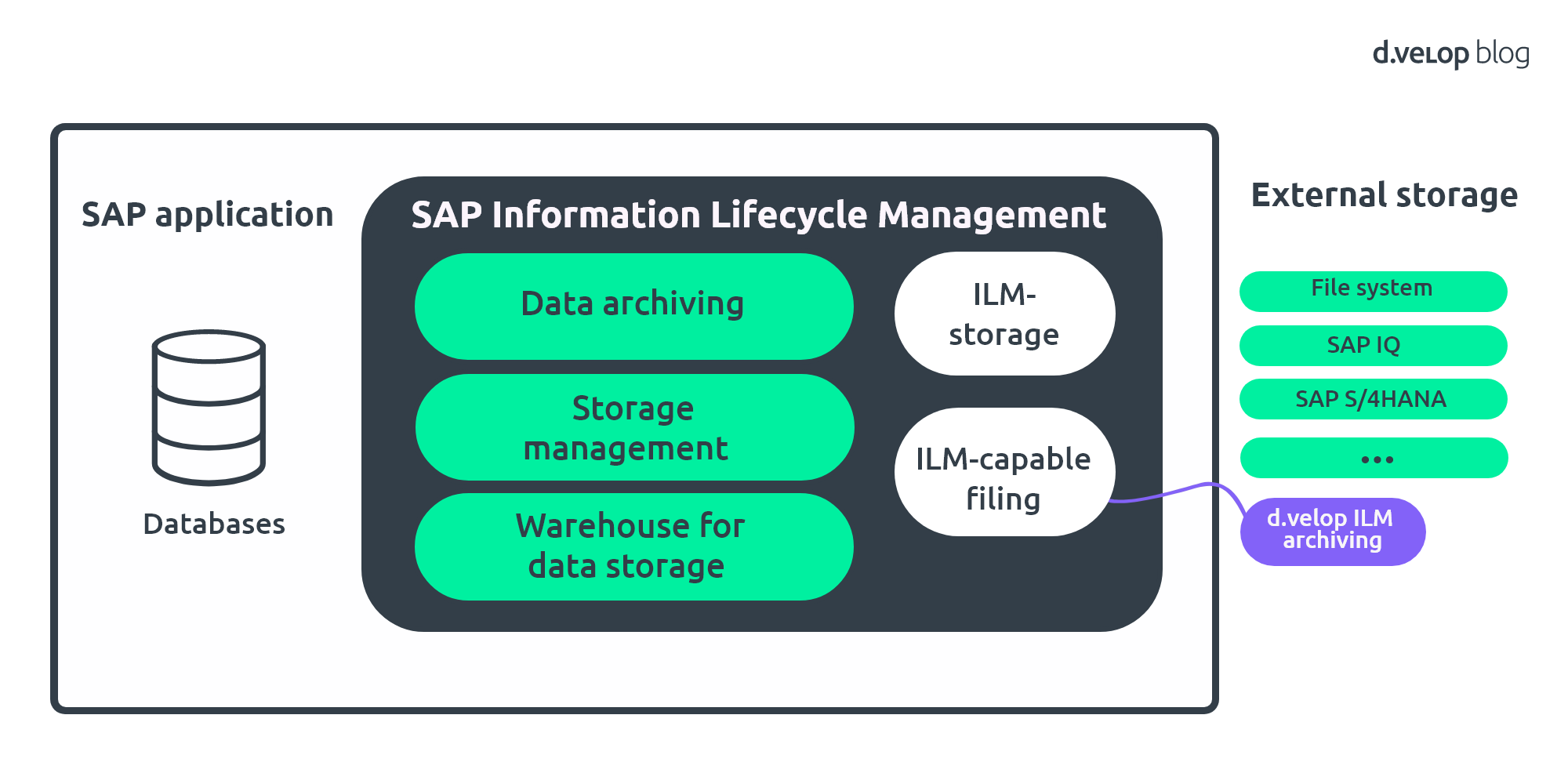In today’s digital world, growing volumes of data are becoming a key challenge for companies. Every company needs to assess its data and find the right way to organise it. SAP Information Lifecycle Management (ILM) is a clever tool for this. In this blog article, we explain why information lifecycle management is so important in organisations and what other benefits the SAP ILM module from d.velop offers.
Definition: SAP Information Lifecycle Management
SAP Information Lifecycle Management (ILM) is an SAP module that is used for the automated management of data. It focuses on a defined data lifecycle that defines how data is handled and when it should be deleted. SAP ILM is designed to relieve the burden on manual data management and archiving processes.
Importance of information lifecycle management in companies
Information lifecycle management (ILM) in organisations includes strategies, methods and applications for the automated provision, access and long-term secure storage of data according to its value and use. Data is a critical element in a company that influences productivity and profitability and requires proper, legally compliant management. An organisation collects, creates, classifies, uses, archives and deletes data.
Automated Information Lifecycle Management helps companies to optimise their applications, reduce infrastructure costs and meet compliance requirements. The importance of correct data management is constantly increasing as data volumes continue to rise, leading to higher storage costs and an increased risk of violating compliance requirements.
SAP Information Lifecycle Management
The SAP ILM module has the following three sub-areas to ensure that the SAP ILM module plays a key role in the comprehensive lifecycle management of documents and secure data archiving:
1. Data archiving
Data archiving is the core element of SAP ILM. This includes the relocation of data that is not used in day-to-day operations. The archiving function of the SAP standard is extended and timely destruction is also possible.
2. Retention management
The Retention Management sub-area controls the life cycle of data. Data is created, stored and destroyed within the framework of predefined sets of rules, blocking functions and deletion concepts as guard rails for different types of data.
3. Retention Warehouse
The Retention Warehouse ensures the decommissioning of entire system landscapes or legacy systems. There is a standardised procedure for this, in which data sets from legacy systems are stored in the SAP ILM Retention Warehouse based on rules. The data is stored until the retention period expires for the purpose of business or tax audits.
Our d.velop solution for SAP Information Lifecycle Management
With SAP Information Lifecycle Management (ILM), SAP offers customers its own solution for the provision, indexing and long-term storage of data. Due to the GDPR, companies are faced with the challenge of archiving this data in accordance with the regulation. This is no easy task, especially in the SAP environment, as the majority of all data from manufacturers, suppliers, customers and employees is directly related to individuals.

With our interface for SAP ILM, we help you to set up technical and organisational measures for blocking and deleting personal data in SAP and to store documents in compliance with the GDPR. In addition to the provision and indexing of personal data within SAP, ILM-capable storage is a central building block in a consistent data protection strategy. With the help of the d.velop ILM interface, (personal) data and its properties can be stored in compliance with the law in order to ensure the retention, blocking and deletion of data over the entire life cycle.
Advantages at a glance: Why SAP Information Lifecycle Management is more than useful for your company
The previous sections have already highlighted some of the advantages of using SAP ILM. The following summarises the advantages once again:
- Data protection-compliant archiving: As explained at the beginning, the GDPR creates new rights for individuals and their personal data. Without productive, legally compliant archiving, with automated deletion concepts and retention periods, compliance with these laws is virtually impossible.
- Reducing data volumes leads to cost savings and better performance: By relocating data from legacy systems that is not required for operational business, companies can streamline their databases and thus save storage space and costs. High data volumes also have an impact on the performance of applications, which can be improved by reducing them.
- Improving data quality: The data volume management functions of SAP ILM look at data inconsistencies, perform data cleansing, synchronise data, standardise and validate. This improves data quality.
- Advantageous in the context of a migration to SAP S/4HANA: SAP ILM can also support companies in the context of a migration to S/4HANA by effectively preparing the data for a migration. The aforementioned benefits of reducing data volumes and improving data quality form the ideal basis for a transformation.
